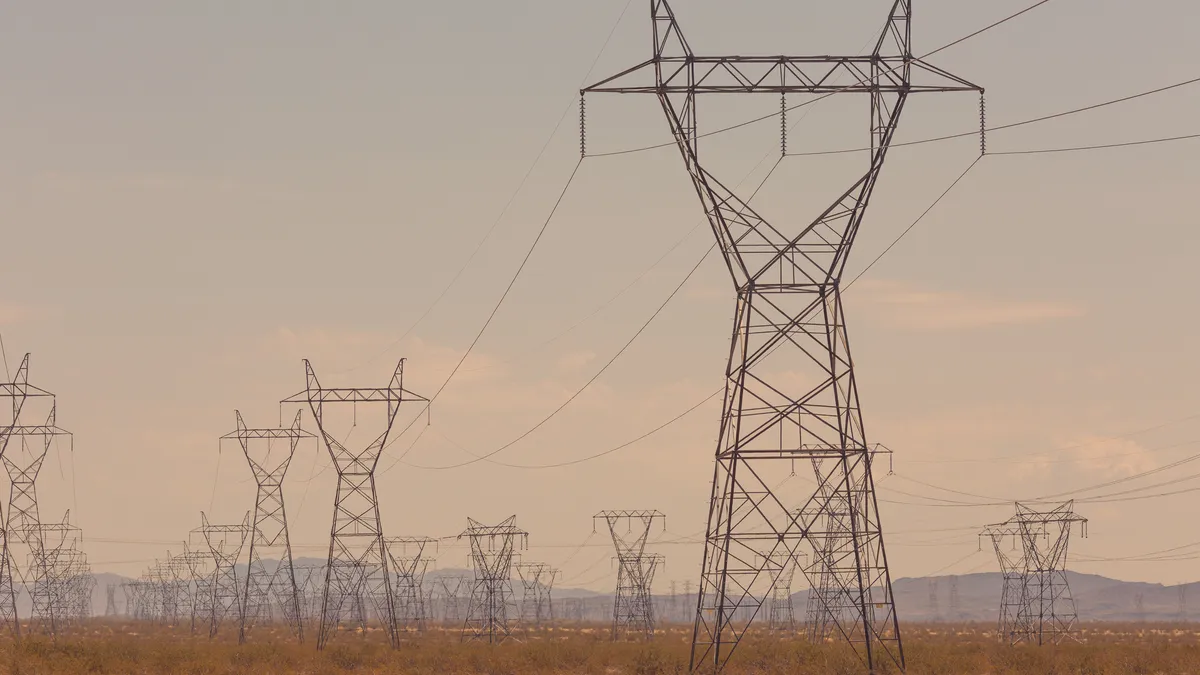Dive Brief:
- A Western regional transmission organization could emerge through a three-step process proposed Wednesday by the West-Wide Governance Pathways Initiative, an effort that includes state utility regulators, utilities, advocacy groups and others.
- In a first step, the proposal calls for increasing the independence of the Western Energy Imbalance Market’s governing body away from the California Independent System Operator’s board. Next, an independent regional organization would be created to oversee the EIM and CAISO’s emerging regional enhanced day-ahead market.
- The Pathways Initiative aims to implement step one by early September and, after refining its proposal, launch a regional organization late this year, Kathleen Staks, Western Freedom executive director and co-chair of the initiative’s launch committee, said at a Nevada Public Utilities Commission workshop Wednesday. Creating a regional organization will require changes to California law, a step that would be pursued next year, she said.
Dive Insight:
Governance questions have been the biggest barrier to building an expanded regional Western market based on the CAISO’s system, according to Mona Tierney-Lloyd, head of regulatory and institutional affairs for Enel North America.
CAISO’s board is appointed by the state’s governor and confirmed by its Senate. Previous efforts to change the governance structure to allow for a regional market failed to pass the state’s Legislature, partly over concerns California could lose control over its energy policies, while other states were leery of joining an organization controlled by California.
The Pathways Initiative — started last year at the urging of utility regulators from five states, including California — aims to solve that problem to create the largest Western power market possible.
The initiative intends to find an acceptable governance framework that could build on the EIM and pending day-ahead market, which are run by CAISO. The initiative includes state regulators, investor-owned utilities — including Pacific Gas and Electric, NV Energy and Arizona Public Service — public power and cooperative utilities, independent power producers, labor unions and others.
“This effort is a coordinated effort across sectors, across states, and having that kind of open communication and a sense of urgency is really refreshing,” Tierney-Lloyd said in an interview.
The Pathways Initiative’s proposal to move in steps towards regionalization was heavily influenced by NV Energy, Evelyn Kahl general counsel for the California Community Choice Association and a launch committee member, said during the PUC workshop. The meeting was held as part of Nevada’s requirement that the utility consider joining an RTO by 2030.
Implementation will move forward if at least 70% of non-CAISO EIM participants join the grid operator’s enhanced day-ahead market, according to Kahl. With Portland General Electric, Idaho Power, PacifiCorp, Los Angeles Department of Water and Power and the Balancing Area of Northern California, which includes the Sacramento Municipal Utility District, planning to or leaning towards joining the day-ahead market, a decision by NV Energy to join the market would trigger the governance transition, Kahl said.
Currently, CAISO and the EIM’s governing body have joint decision-making authority over the EIM, a real-time market that serves about 80% of Western load. Under the proposal, the EIM’s governing body would have primary authority. The governing body’s market-related decisions would go to the CAISO board for approval and if there was a disagreement, an existing dispute resolution process would begin, according to Kahl. If the dispute is unresolved, the two proposals would go to the Federal Energy Regulatory Commission for review in a single “jump ball” filing that would indicate no preferred outcome.
“Step 1 is a near-term incremental increase in independent governance that shows commitment to that trajectory while continuing to protect reliability, control costs for consumers, and respect state policies,” the Pathways Initiative said in its proposal.
The proposal’s second step calls for creating a non-profit regional organization that would take over from the EIM’s governing body. The organization could provide new services beyond the energy markets, such as reliability coordination, transmission functions and balancing authority consolidation, according to the proposal.
The proposal is designed to make sure that nothing in a new governance structure would prevent the creation of an RTO, Kahl said.
“As Step 2 matures, the Launch Committee contemplates further evolution toward services of an RTO for balancing authorities ... and other market participants to join voluntarily,” the proposal said.
There is “natural progress” in the West towards an RTO with the creation of the EIM in 2014 and the pending enhanced day-ahead market, set to begin operating in 2026, Mark Rothleder, CAISO senior vice president and chief operating officer, said at the workshop.
“We recognize that the market governance needs to evolve,” he said.
The Pathways Initiative marks a “fundamentally different” approach to changing the markets’ governance compared to earlier failed attempts, according to Varner Seaman, director of legislative and regulatory affairs at Pattern Energy Group.
In the past, California took a “go it alone” approach that was opposed by the International Brotherhood of Electrical Workers and others, Seaman said in an interview, noting the IBEW has signaled it generally supports the Pathways Initiative.
“This is much more of a conversation between stakeholders and different voices, large customers, utilities, regulators, labor organizations, the [independent power production] community,” Seaman said. “We're coming up with something which is collaborative to take back to the states as opposed to one state saying, ‘This is the way we're gonna go, come join us.’ And I think that's just a fundamentally different approach.”
While Pattern supports market development generally, including the Southwest Power Pool’s Markets+ initiative, studies have shown the larger the market the more benefits it can bring, according to Seaman. As a result, it makes sense that including CAISO in a Western market makes the most economic sense, he said.
The Pathways Initiative is holding a stakeholder meeting April 19 to review its proposal and comments are due May 8.















